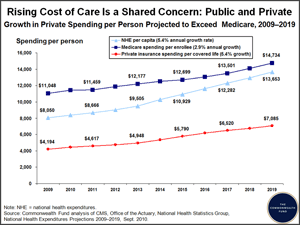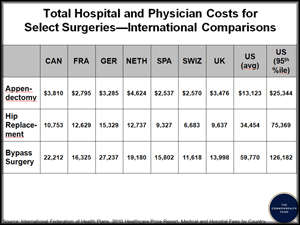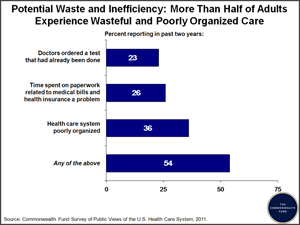Federal health care spending remains front and center as Congress continues to search for ways to reduce the budget deficit and improve the nation’s return on its significant expenditure on health. According to the Centers for Medicare and Medicaid Services, the federal government spent approximately $750 billion on Medicare and Medicaid in 2009—more than 20 percent of the total federal budget and almost 6 percent of the nation’s entire gross domestic product (GDP).1
Given persistent budgetary pressures, it’s not surprising that the Administration and Congress are weighing options for achieving savings in the Medicare and Medicaid programs. It’s important, however, to bear three points in mind.
First, the Affordable Care Act already instituted major reforms to slow Medicare spending per beneficiary, which is projected to grow at 2.9 percent annually over 2009–2019. The projected increase in Medicare spending is slower than GDP per capita, and substantially slower than private health insurance spending per person.2 Currently, Medicare covers less than 75 percent of the average beneficiary’s total health expenditures, and beneficiaries with serious health problems or low incomes bear significant out-of-pocket spending burdens.3
Second, because of persistent, longstanding pressure on state budgets, Medicaid has much lower provider payment rates than Medicare and private insurance have, and this undermines providers’ willingness to participate in the program.4 Medicaid beneficiaries are among the sickest and poorest Americans: the frail elderly in nursing homes, disabled adults, and impoverished families. Given the vulnerability of those Medicaid covers, cutting benefits, increasing cost-sharing for health care services, or reducing Medicaid eligibility are not viable strategies.
Third, federal revenues as a percent of GDP are the lowest in 60 years. Since 1950, federal tax revenues have averaged 17.9 percent of GDP, while expenditures have averaged 19.9 percent. In 2010, while outlays were 23.8 percent of GDP—3.9 percentage points above the average over that period—revenues were 14.6 percent, or 3.3 percentage points below the average over the previous 60 years. Both the economic contraction and cuts in tax rates over the last decade are responsible for the drop. A balanced approach to managing the deficit would involve restoring revenues as well as looking for opportunities to control federal budget outlays. 
Achieving Savings
There are three basic ways to reduce Medicare and Medicaid spending:
- cutting eligibility or benefits—that is, reducing the number of people, the range of services, or the share of spending covered by the programs;
- trimming payments by reducing the prices paid for covered services; or reducing utilization of services.
- While the third way is sometimes disparagingly referred to as rationing, there is a significant body of research showing that when patients receive the right care for their condition, and in the right amount, we can not only reduce the total cost of treatment but also improve access, quality, and outcomes.5
Cutting Eligibility and Benefits
During the federal budget deliberations, a number of proposals have been advanced that would reduce Medicare and Medicaid spending by cutting eligibility or benefits. These include proposals to:
- give states more flexibility to reduce Medicaid eligibility;
- block-grant Medicaid, giving states wide discretion to reduce benefits and eligibility;
- raise the age of eligibility for Medicare to age 67;
- income-test eligibility, premiums, or cost-sharing for Medicare beneficiaries;
- convert Medicare to a voucher to be used for the purchase of private insurance, with the value of the voucher set below what Medicare would otherwise be projected to spend; increase Medicare cost-sharing, by instituting increased out-of-pocket requirements and/or prohibiting first-dollar coverage under private supplemental policies; or
- convert Medicare to a high-deductible health plan tied to a health savings account.
Nearly all of these policies would have serious adverse effects on elderly, disabled, and low-income families, with disproportionate impacts on those who are sickest or poorest.
A different set of policies could be designed to deter use of unnecessary or duplicative care and encourage use of lower-cost sources of care. These policies could be structured so that costs wouldn’t be shifted to beneficiaries on average, but would instead be redesigned to guide wiser patient choices. Policies along this line could include:
- Targeting Medicare cost-sharing on discretionary care, by reducing or eliminating copayments for essential services while increasing cost-sharing for services that are supply-sensitive.
- Reducing Medicare cost-sharing on services over which patients have little discretion (such as hospitalizations), while introducing modest copayments on services like home health visits, which currently have no copayments.
- Instituting value-based benefit design, by eliminating or reducing cost-sharing for primary care, prescription drugs that are essential for controlling chronic conditions, and other services that are highly cost-effective.
- Using “reference pricing”—that is, charging patients the difference between the lowest price for an effective prescription drug, medical device, or procedure and the price of a similar but more expensive one that does not offer higher quality.
- Offering tiered or “elite” networks: charging patients less for getting a coronary bypass, say, from surgeons or hospitals that achieve the same or better outcomes, lower mortality, or fewer complications than other providers, but cost less over the course of treatment.
Even in the Medicaid program, which doesn’t rely on cost-sharing because of the very low incomes of the people it covers, positive financial incentives could encourage use of important but underutilized services, such as prenatal care in the first trimester of pregnancy, asthma-control medications, or the designation of a patient-centered medical home.
Trimming Payments
A second strategy for achieving savings is to trim provider payments. In general, Medicaid already pays substantially below Medicare rates, and Medicare typically pays less than private insurers do. Providers have argued that they need to raise prices to private insurers to compensate for the lower rates from Medicare and Medicaid. Recent literature suggests, however, that when revenues from private insurers are constrained, hospitals tend to operate more efficiently, plus they realize higher margins from Medicare.6 
There may be some services where price reductions may be in order. For example, the typical price paid in the U.S. for brand-name drugs and medical devices, such as hip replacements, is about twice what it is in other countries. To address such market inefficiencies, new policies might authorize Medicare and Medicaid to negotiate prices for prescription drugs, medical devices, and durable medical equipment.
The Independent Payment Advisory Board
The Affordable Care Act provides new tools that could also help address both federal and total health system spending. One crucial tool is the Independent Payment Advisory Board (IPAB). While the board is currently charged with identifying areas of overpayment in Medicare, its scope of authority could be broadened to include issuing recommendations for Medicaid and private insurer payment policies. The combined leverage of multiple payers could yield prices closer to competitive market prices, as well as greatly reduce administrative burdens on physician practices and hospitals—all while stimulating delivery system improvement and innovation.
Similarly, the IPAB could explore the potential of reference pricing to both lower spending and improve the quality and effectiveness of care that beneficiaries receive. Other countries commonly use this approach not only to save money but also to provide appropriate incentives for innovation that leads to improved clinical outcomes.
Also within the IPAB’s purview is an array of payment approaches designed to encourage providers to become more accountable for the quality and cost of care beneficiaries receive. Promising examples include bundled payment for all the services provided during an episode of care, as well as strategies that facilitate closer, more effective management of patients with multiple chronic conditions. In this regard, the IPAB can and should work closely with the new Center on Medicare and Medicaid Innovation. Previous Commonwealth Fund research has demonstrated how these collaborations can be pursued both from the “top down,” with the federal government leading the way, as well as from the “bottom up,” with the federal government joining initiatives developed and implemented by local stakeholders.7
Finally, and perhaps most importantly, the scope of the IPAB’s authority could be broadened to include working with private-sector payers on ways to foster collaboration between public and private initiatives to improve the organization and delivery of health care and slow cost growth. Given the Congressional Budget Office’s finding that 55 percent of the projected increase in federal health spending over the next 25 years can be attributed to excess growth in health care costs—a problem that plagues businesses, households, and federal, state, and local government alike—it seems clear that the only way to control federal health spending is to control total health spending.
Ensuring the Right Care
Any proposal to reduce utilization of services is often characterized as rationing—denying patients the right to life-saving care. Yet surveys of the American public indicate that more than half of patients experience duplicative tests or poorly organized care.
Research studies also show substantial misuse, overuse, or underuse of services. The Institute of Medicine estimated that as many as 98,000 patients die in hospitals each year as a result of medical errors that could have been prevented.8 The Medicare Payment Advisory Commission calculated that 13.3 percent of hospital readmissions within 30 days of discharge are avoidable.9 Researchers at the RAND Corporation, meanwhile, found that patients, on average, receive only 55 percent of recommended care for their health conditions.10
One way to encourage more appropriate utilization and reduce hospitalizations or readmissions is to give physicians and hospitals incentives to coordinate care better, improve patient outcomes, and reduce the resources needed to provide good care. Policies that embrace this strategy include:
- incentives for primary care practices, community health centers, and health clinics to convert to patient-centered medical homes;
- shared savings for accountable care organizations;
- value-based purchasing, with rewards for better quality or better patient outcomes;
- bundled acute and post-acute care global fees; and
- gain-sharing arrangements between hospitals and inpatient physicians.
The Affordable Care Act provides for all of these strategies, including broad authority for the Innovation Center to pilot test a broad array of payment and delivery system reforms. Continued funding, acceleration, and expansion of this work should be supported. Further, the IPAB should have the flexibility to quickly adopt and spread successful innovations throughout the Medicare and Medicaid programs. 
States are also leading a number of innovations to transform the delivery of health care, often joining with commercial payers. Thirty-eight states are pursuing support of patient-centered medical homes.11 Forty-three states use some form of value-based purchasing.12 Some states, such as Maryland, are paying hospitals a global per capita rate for caring for all patients in a given geographic area.
The challenge is not the absence of creative ideas for achieving savings while improving care. Rather, it is the distraction of ideologically driven arguments pitting market-based solutions against government-based ones. In truth, it will take a concerted effort by public programs and private payers to reduce administrative costs, leverage change, and yield more rapid transformation of the health care system.
Notes
1 A. Martin, D. Lassman, L. Whittle et al., and the National Health Expenditure Accounts Team, “Recession Contributes to Slowest Annual Rate of Increase in Health Spending in Five Decades,” Health Affairs, Jan. 2011 30(1):11–22.
2 A. M. Sisko, C. J. Truffer, S. P. Keehan et al., “National Health Spending Projections: The Estimated Impact of Reform Through 2019,” Health Affairs, Oct. 2010 29(10):1933–41; and C. J. Truffer, S. P. Keehan, S. Smith et al., “Health Spending Projections Through 2019: The Recession’s Impact Continues,” Health Affairs, March 2010 29(3):522–29.
3 D. Yamamoto, T. Neuman, and M. K. Strollo, How Does the Benefit Value of Medicare Compare to the Benefit Value of Typical Large Employer Plans? Issue Brief (Menlo Park, Calif.: Henry J. Kaiser Family Foundation, Sept. 2008); and J. Cubanski, A. Damico, L. Dawson et al., “Health Care on a Budget: The Financial Burden of Health Spending by Medicare Households,” Kaiser Family Foundation Program on Medicare Policy Data Spotlight, June 2011.
4 D. Bachrach, Payment Reform: Creating a Sustainable Future for Medicaid, Policy Brief (Hamilton, N.J.: Center for Health Care Strategies, May 2010).
5 P. R. Orszag, “The Overuse, Underuse, and Misuse of Health Care,” statement before the Committee on Finance, U.S. Senate, July 17, 2008.
6 Medicare Payment Advisory Commission, Report to the Congress: Medicare Payment Policy (Washington, D.C.: MedPAC, March 2011).
7 S. Guterman, K. Davis, K. Stremikis, and H. Drake, “Innovation in Medicare and Medicaid Will Be Central to Health Reform’s Success,” Health Affairs, June 2010 29(6):1188–93.
8 Institute of Medicine, Committee on the Quality of Health Care in America, To Err Is Human (Washington, D.C.: National Academies Press, 2000).
9 Medicare Payment Advisory Commission, Report to the Congress: Promoting Greater Efficiency in Medicare (Washington, D.C.: MedPAC, June 2007).
10 E. A. McGlynn, S. M. Asch, J. Adams et al., “The Quality of Health Care Delivered to Adults in the United States,” New England Journal of Medicine, June 26, 2003 348(26):2635–45.
11 National Academy for State Health Policy, “Medical Home States” (Web page), http://www.nashp.org/med-home-map.
12 K. Kuhmerker and T. Hartman, Pay-for-Performance in State Medicaid Programs: A Survey of State Medicaid Directors and Programs (New York: The Commonwealth Fund, April 2007).




